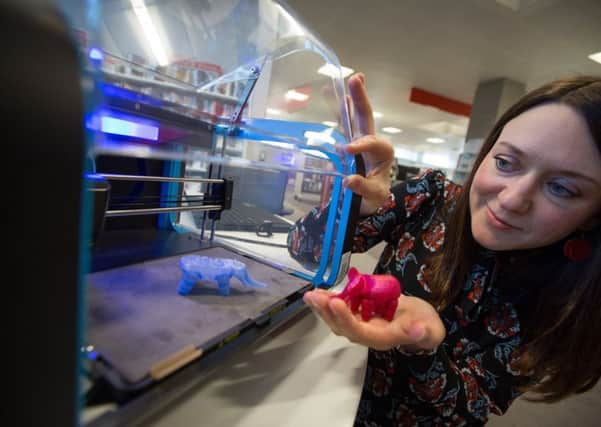Pamela Tulloch: 21st century libraries are more popular than football


It’s a traditional image of libraries that holds a strong position in our collective minds. However, as we forge further into the 21st century, and the ongoing transformation of public libraries gathers pace, our perceptions and Google’s image results will, I hope, change.
Increasingly, they are more likely to resemble a thriving hub of community-based activities, attracting people of all demographics for various purposes, than quiet reading rooms and bookshelves.
Advertisement
Hide AdI recently heard an uplifting story that underlined the changing face of Scotland’s public libraries. Staff at Dunblane Library persuaded an elderly man, who lived nearby, to attend one of their ‘Digiknow’ sessions, where they showcase IT and digital services, including 3D printing.
The senior gentleman duly turned up, fairly indifferent to the event. However, when he saw the 3D printer in action he made an immediate connection. He went home and returned soon after with a cracked dial from his cooker and was able to print a new one.
This is a perfect example of innovation in libraries and how they are adapting their services to meet the needs of modern users.
I regularly field questions about the relevance of public libraries, with the continually evolving nature of digital technology, reduced investment, and library closures seen as signs of declining significance.
It’s true that library services have suffered a disproportionate amount of budget cuts since 2010 and some libraries have closed in Scotland. That is undeniable. However, this is only part of the picture and closures obscure a positive and inspiring landscape.
In most cases, closures have been a result of review and reinvestment in library services, as older buildings and service points make way for brighter, more modern facilities, including shared community campuses.
Advertisement
Hide AdIn the last 18 months, 14 new or refurbished libraries have opened across Scotland. Even in these cash-strapped times, local authorities and culture trusts are prioritising libraries.
Most encouragingly in Scotland, visitor numbers continue to rise, cementing public library services as the most popular civic resource offered by local government. Since 2010, visits to Scotland’s public libraries – including online ones – have increased from 39.8 million to over 43 million, which is around a nine per cent increase and is more than SPFL football match attendance and cinema visits combined.
Advertisement
Hide AdVirtual visits account for the largest area of growth, demonstrating how library user consumption is changing in line with technology.
Far from making libraries redundant, digital technology has fuelled a next-generation role for libraries. They have moved with the times and embraced the online world. The age group using Scotland’s libraries the most is 24-44-year-olds, so a digital offer needs to be core.
There has also been a 12 per cent increase in use of online services, such as downloadable ebooks, emagazines and music streaming. Services have been tailored and developed, and include a wide range of initiatives, from the rollout of free wifi, introduction of 3D printers and development of Code Clubs for children. We’re currently exploring the possibility of introducing virtual reality experiences into public libraries to extend the ways people find information and improve their knowledge.
At the same time, ‘offline’ services in libraries are transforming. It is commonplace for libraries to offer a range of literacy initiatives for children and adults. Jobseekers can access information and advice on benefits, job vacancies and interview techniques. Film screenings, history exhibitions and even dance classes are helping to widen people’s cultural experience. A health and well-being offer to promote self-management of personal health is growing, supported by key partnerships with health charities and the NHS, building on the hugely successful Macmillan cancer support groups in libraries.
Midlothian Libraries has integrated a groundbreaking health and well-being initiative in partnership with the NHS. Hearing aid battery replacement has moved from outpatient departments in hospitals into local libraries. It has been a life-changing move for some local residents, ensuring people have functioning hearing aids and saving travel costs. Libraries in Midlothian have issued 12,462 battery packs since the initiative started a couple of years ago.
For many users, it is the position at the heart of communities that libraries inhabit that makes them so valuable. They are a trusted local space where everything from ‘digital makerspaces’ to ‘knit and natter’ classes are taking place.
Advertisement
Hide AdInnovative projects are repositioning the public library offer beyond the traditional book-lending service. Books are still extremely important, but as demand changes, so must the service delivery model.
It is important to acknowledge closures and the potentially devastating impact such decisions can have on communities. But it is also important to note the tremendous resilience the public library sector has shown in the face of widespread fiscal challenges and to accept that our current perceptions of libraries may be outdated.
Advertisement
Hide AdLibraries are carving out a role that remains true to their traditional ethos, but embracing change and innovation. They cut across and contribute to all areas of social, cultural and political life, giving people equal access to services, resources, information. Libraries are here to stay and their role today is as relevant as when they were first established.
Pamela Tulloch is chief executive at the Scottish Library and Information Council
